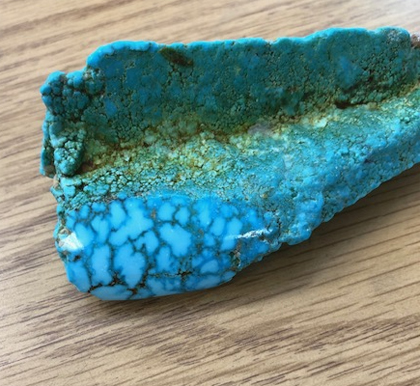Turquoise Defined
The mineral turquoise is stunning mineral that comes in gorgeous tones of green, blue-green, multiple ranges of blue and multiple ranges of green. It is a gemstone that has been highly desired by man for several thousand year. Separated by entire continents, the pre-historic people of the America’s, Asia and Africa all chose turquoise as a favorite natural ingredient for small art works, custom jewelry inlay and treasured gemstones.
The chemical make-up of turquoise is CuAl6(PO4)4(OH)8·4H2O, which in ordinary terms is hydrous phosphate of copper and aluminum. It is color that is treasured throughout the world, but as a material its primary use is the production of both jewelry and artistic pieces. It is incredibly well liked and well known to the point of being employed as the description of a color that is the common for high-end turquoise stones.
Hardly any mineral on earth is a color that is known to the point in a language that the name of the mineral is also the one used for a color. Common language for the minerals that align with turquoise as mineral and a color in the same way are copper, silver, and gold.
The Multiple Colors of Turquoise
In nature mineral that is blue is not common at all. This fact is why the gemstone turquoise grabs high interest by both consumers and jewelers alike. Sky blue or robin egg blue is the most popular and sought-after turquoise color. Many folks label this color “Persian blue”, name because of the popular high-end turquoise mined in the country of Iraq. Employing the name of a geographical location for a gemstone mineral must strictly be used if the mineral deposits come from a specific location.
Following the most popular turquoise gemstone color blue are bluish green, inclusive of green and then finally yellowish green material. When turquoise is not blue it is due to the fact it contains iron instead of aluminum. The more iron in the material the more greenish tint will be found in the turquoise. Turquoise color is also impacted by portions of zinc and iron built into the make-up of the material instead of copper.
Turquoise material often has components of the rock where the turquoise formed. This is known as matrix and it show up in turquoise in brown and black spider-webbing or distinct patches. Quite often turquoise stone cutters make stones that do not include the matrix, but occasionally the matrix is so woven into the material that there is no way to make this happen. There are some jewelry aficionados that desire matrix turquoise stones or inlay, but turquoise stones and inlay with lots of matrix as a common fact is not desired very much on overall basis.
Certain mine locations are famous for producing turquoise material with a specific color and look. Light blue turquoise with no matrix comes from the Sleeping Beauty Mine. Stunning blazing blue containing lots of black spider web matrix comes from the Kingman Mine. Deep dark blue turquoise comes from the Morenci Mine. Brilliant blue turquoise with matrix that is chocolate brown comes from the Bisbee Mine. Turquoise aficionados are normally able to tell you what mine a turquoise comes from base on its color.

